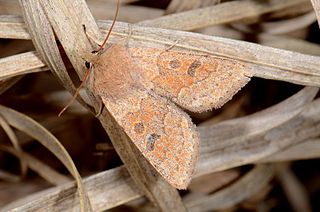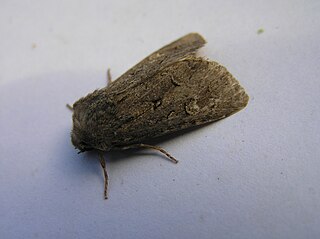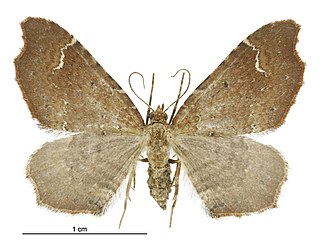
The pine beauty is a moth of the family Noctuidae. It is a common species of pine woods in Europe. The distribution area extends from Portugal to western Siberia, the Caucasus and Asia Minor. In the north it extends to the Arctic Circle, in the south it is found in Ceuta in Northern Africa in and southern Italy.

The mouse moth is a moth of the family Noctuidae. It is a widespread species with a Holarctic distribution.

The angle shades is a moth of the family Noctuidae. The species was first described by Carl Linnaeus in his 1758 10th edition of Systema Naturae. It is distributed throughout Europe as far east as the Urals and also in the Azores, in Algeria, and in Asia Minor, Armenia, and Syria. It is strongly migratory.

The straw underwing is a species of moth in the family Noctuidae. The species was first described by Johann Siegfried Hufnagel in 1766. It is found from North Africa west through South Europe and Central Europe. In the north it is in parts of Ireland, Scotland, Sweden, Norway, Finland and Estonia. Further east the range stretches from southern Russia and Asia minor to the Caucasus.

Apamea sordens, the rustic shoulder-knot or bordered apamea, is a moth of the family Noctuidae. The species was first described by Johann Siegfried Hufnagel in 1766. It is distributed throughout Europe, east across the Palearctic to Central Asia and to China and Japan. It also occurs in North America.

Orthosia miniosa, the blossom underwing, is a moth of the family Noctuidae. The species was first described by Michael Denis and Ignaz Schiffermüller in 1775. It is found in Europe.

Luperina testacea, the flounced rustic, is a moth of the family Noctuidae. It is found in Europe, Asia Minor and Armenia.

Caradrina clavipalpis, the pale mottled willow, is a moth of the family Noctuidae. The species was first described by Giovanni Antonio Scopoli in his 1763 Entomologia Carniolica. It is found in the Palearctic realm. It is an introduced species in North America, where it was first reported from Queens in New York City in 1993. In 2009 it was found in Rochester, New York, so it appears to be established and spreading.

Caradrina kadenii, or Clancy's rustic, is a moth of the family Noctuidae. The species was first described by Christian Friedrich Freyer in 1836. It originates from southern and central Europe, Asia Minor and southern Russia but in the 21st century it has extended its range to the north.

Rhizedra lutosa, the large wainscot or Isle of Wight wainscot, is a species of moth of the family Noctuidae. It is native to the Palearctic realm. It has been introduced into eastern North America and is spreading.

Mesapamea secalis, the common rustic, is a moth of the family Noctuidae. The species was first described by Carl Linnaeus in his 1758 10th edition of Systema Naturae. It is found in Europe, north-west Africa, Turkey and northern Iran.

Acrapex roseotincta is a species of moth of the family Noctuidae first described by George Hampson in 1910. It is found in Sri Lanka.

Agrotis trux, the crescent dart, is a moth of the family Noctuidae. The species was first described by Jacob Hübner in 1824. It has a circum-Mediterranean distribution and is found along the coasts of France, Ireland, England, southern Europe, Algeria, Syria, Iraq, Iran, southern Russia and the Arabian Peninsula. In Africa, it is found as far south as South Africa.
Homoeosoma striatellum is a species of snout moth in the genus Homoeosoma. It was described by Harrison Gray Dyar Jr. in 1905. It is found in North America, including Arizona, California and Nevada.

Parastichtis suspecta, the suspected, is a species of moth in the family Noctuidae. It is found from most of Europe through Russia and east through the Palearctic to Japan. It is also found in North America.
Somatina purpurascens is a moth of the family Geometridae first described by Frederic Moore in 1887. It is found in Sri Lanka.
Gymnoscelis deleta is a moth in the family Geometridae. It is found in India, Korea, Japan, Taiwan and probably in Sri Lanka according to Hampson.

Ichneutica oliveri is a moth of the family Noctuidae. It is endemic to New Zealand, found only in the South Island. However it has not been observed on the eastern side of that island from mid-Canterbury southwards to Southland. This species is distinctive and is unlikely to be confused with other closely related species. It inhabits tussock grasslands, shrubland as well as granite sand plains, all in the alpine zone. Adults are on the wing from December to March and are attracted to light. They have been observed feeding on the flowers of Hebe species. The life history of this species is unknown as are the larval hosts.
Streptoperas luteata is a moth in the family Drepanidae. It was described by George Hampson in 1895. It is found in the north-eastern Himalayas and on Borneo, Sumatra, Java, Bali and Sulawesi.

Asaphodes camelias is a species of moth in the family Geometridae. It is endemic to New Zealand and inhabits native forest. The adults of this species are on the wing from February to May and July to September.














